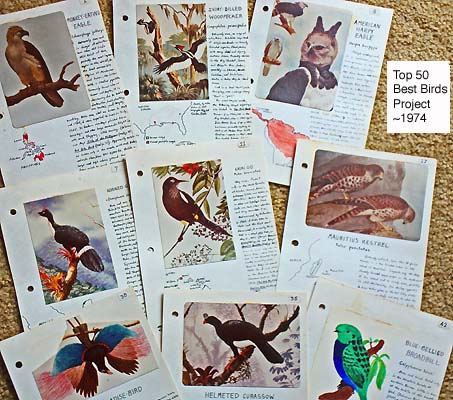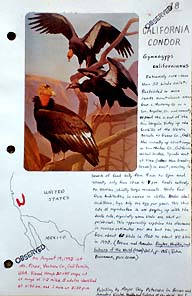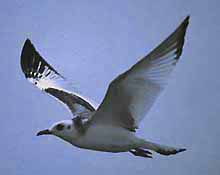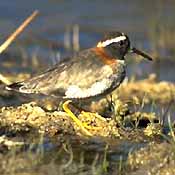| |
|
| This project presents my choices for the "fifty best birds in the world." This is a concept with which I have been toying since 1974, and by this writing that is more than 50 years ago. An introduction to the concept and its background is below; my actual choices are reached via the links to the right. |
|
|
The concept is to weigh and balance how impressive, how unique, how rare, and how hard to find each extant bird is, consider any special circumstances surrounding that species (e.g., almost went extinct or a history of mystery), and ensure a diverse selection across continents and oceans, and throughout the spectrum of bird families.
This is not a list of the "rarest birds" on earth. If it were, when I started in 1974, just based on rarity, then species like Seychelles Warbler Acrocephalus sechellensis (population down to 50 birds in 1965 but since recovered) or Raso Skylark Alauda razae (only 92 birds found in a 1998 survey) would have been considered. It would be great to see such rarities — indeed, I have gone to see the Seychelles Warbler — but there are dozens of Acrocephalus warblers and several Alauda larks in the world, many of which are very similar and none of which are very impressive compared to, say, a Harpy Eagle or Resplendent Quetzal. I'd love to see all the world's birds but if I could only have one view of either a Harpy Eagle or a Raso Skylark, well, I'll chose the eagle any day. Although I am very keen on "little brown jobs," there are no brush-warblers, cisticolas, or Empidonax flycatchers in my list of the "50 Best Birds." There have been, however, two rather dull birds on the list because they do astonishing things: building a spectacular bower or engage in dramatic courtship flights (only the former is still on the list).
Although my project was an original idea when I started it in 1974, the concept of picking "best birds" or "50 birds to see before you die" (sometimes called a "bucket list") gained popularity after the 2007 movie The Bucket List with Jack Nicholson & Morgan Freeman (about a list of things to do or places to visit before you die). I've recently seen on-line "bucket lists" for "must see birds" proposed from the U.K. to Peru to Australia. More details on my personal process is below. |
|
 My concept has gone through various versions over the years as I learned more about some of the world's great birds, and as I refined my thinking on the topic. This is about my seventh major version of the list, and I still dicker with it now and then. My concept has gone through various versions over the years as I learned more about some of the world's great birds, and as I refined my thinking on the topic. This is about my seventh major version of the list, and I still dicker with it now and then.
My first effort was during college, in about 1974. This was before my first world birding in Colombia in 1975. I created a loose-leaf binder with my initial choices, each one represented with a page that included a photo of some artwork and hand-written details and a map. [I couldn't find a picture of Hose's (then called "Blue-bellied") Broadbill, so I tried painting my own.] I considered this my "most wanted world birds" list, and since it was a loose-leaf notebook, the choices could be rearranged as my thoughts changed over the years. Back in 1974, my "top 50" choices included birds such as Ivory-billed Woodpecker, Ou, Imperial Woodpecker, Kauai Oo, and others then nearing extinction or already extinct. None of these are included now. |
 In my initial project, as I was able to observe some early choices (e.g., Scarlet Macaw or California Condor, right) they dropped off the list and new selections were added. I'd stamp "Observed" on the old page and write in a few details of my own sighting. My original "top 50" list in 1974 included 10 pheasants and 4 curassows. Although all were wonderful birds, that was just "too many chickens," as Guy McCaskie said when he saw the binder. I've since made a conscious effort to diversify among the bird families, and to reduce the number of "chickens" in the list. In my initial project, as I was able to observe some early choices (e.g., Scarlet Macaw or California Condor, right) they dropped off the list and new selections were added. I'd stamp "Observed" on the old page and write in a few details of my own sighting. My original "top 50" list in 1974 included 10 pheasants and 4 curassows. Although all were wonderful birds, that was just "too many chickens," as Guy McCaskie said when he saw the binder. I've since made a conscious effort to diversify among the bird families, and to reduce the number of "chickens" in the list.
In the next major incarnation of the list, placed on my web site in 1999, whether or not I'd personally seen a bird became irrelevant in evaluating the "best birds" of the world. Otherwise my general concept remained similar but I added a layer of "requirements" that forced diversity across the glove, limiting myself to only 10 or 11"best birds" each from Asia and the Neotropics, 6 or 7 each from Africa & Australasia & the Oceanic Island (Madagascar etc.), 3 from the Nearctic or the Western Palearctic, 2 pelagics in the Ocean realm, and 1 in Antarctica. But forcing myself to include a certain number of North American or European species, instead of some tropical birds that captured my imagination more, eventually became tiresome. These restrictions have been abandoned (but, still, I try to keep the list very diverse). |
In preparing a predecessor to this current version, I assigned points between 0–5 in five separate categories: (1) how impressive, (2) how unique, (3) how rare, (4) how hard to find, and (5) special circumstances, and tallied the points on a spreadsheet. Here's a bit more on the system:
- Impressive? Big powerful raptors, huge albatrosses and cranes, and gorgeous tropical birds are "more impressive" to me than cisticolas or Cookilaria petrels. Although I love cisticolas and have done research on the small Pterodromas, we humans are stirred by wildlife that is big, fast, fierce, and colorful. On the other hand, in some species sexual dimorphism has produced spectacular males and smaller, drabber females (e.g., hummingbirds, manakins, birds-of-paradise). I have taken this into account to some degree, but still chose species in which it is the male that is "impressive," recognizing that sometimes the birder must "settle" for views of the less-impressive female or young. I also chose one bowerbird whose bower is overwhelmingly impressive, even though both sexes of the bird itself are very plain.
- Unique? The Kagu and Shoebill are unique birds and rate "5" in that category. Contrast that with the seven blue cotingas the genus Cotinga. Each is an absolutely stunning bird but none is "unique" with six close relatives looking equally beautiful. When it narrows down to just two or three similar birds, however, I begin to think of them as almost unique. To facilitate the list and create diversity, I permitted myself the choice of "any" of three or more closely-related species (usually within the same genus) when (a) as a group they are indeed unique, (b) together the sibling species form a superspecies in a similar geographic region, and (c) each of the various species is scarce and hard to see. You will thus find the choices any Tragopan, any Kiwi or any Cassowary; in a way this makes the project the "top 60" birds, but I can live with that. However, when there are only two such similar species, and each would make the "top 35," then each is entitled to a separate place on the list when they individually score high enough in the other categories. Such pairs are both rockfowl adn cock-of-the-rock, and both huge white cranes.
- Rare? Almost all birdwatchers enjoy rare birds; it is a special feeling to be in the presence of something rare. I have often referred to BirdLife International's (2000) Threatened Birds of the World for population estimates. In general, the rarer a bird is the more it is desired. Note, however, that I have not included in my consideration those species that are extent -- some of the recently -- or others teetering on the edge of extinction. So Ivory-billed Woodpecker, Oo, Ou, Kinglet Calyptera, White-eyed River-Martin, or Slender-billed Curlew were no longer consider, nor were species that still exist but there is no public access (e.g., Night Parrot). I've also recently decided that the flightless parrot Kakapo, limited to tiny offshore islets that only researchers can visit, does not quaify for this project.
- Hard to find? This is not the same thing as "rare." The Seychelles Magpie-Robin Copsychus sechellarum was definitely rare when I saw it — only 23 birds left in the world — but it was not hard to find. Assuming you had time and money, you could fly to the Seychelles easily and no political turmoil prevents that; you could then fly to Fregate Island in a small plane, land and see the magpie-robin within a short level 10 minute walk. But no amount of time or money will guarantee you a look at a Congo Peafowl.
- Special circumstance? Almost any bird considered for the list is special; this category is my own much more subjective category and may include the bird's history. The Short-tailed Albatross was almost entirely wiped out a half-century ago; when I began birding it was considered impossible to see. So when I did see one, it was extra special for me. California Condors became extinct the wild in 1987 when the last six were captured for captive breeding, but now small populations are breeding in various parts of western North America. Mauritius Kestrel went through an evolutionary bottleneck when only a lone breeding pair remained in 1974, and they have recovered. I've always wanted to see these birds. In addition, birds like Great Argus and Long-tailed Ground-Roller were considered near mythical when I started birding the world about 1975, and the search for them has been a wonderful quest. This category is personal and elevates a few birds to the list over some equally qualified candidates that don't mean as much to me. Still, over time, and as populations grow and the ease of seeing them has improved, neither Argus nor the Maritius Kestrel is on the current version of this list.
Here are a couple of examples of how my system was constructed. Palmchat Dulus dominicus of Hispaniola is assigned to its own monotypic family; it is thus "unique" in some sense and might score at 3 or 4 in that category. But it is neither "impressive" nor "rare," and it is about the easiest native bird to see in the Dominican Republic. You just have to get there. So the points in those categories might be 0, 0, and 1. Without any special personal connection or history, it will total out at about 4 or 5 points.
 Or consider my personal web moniker, the Swallow-tailed Gull Creagrus furcatus (right) of the Galapagos Is., and wintering in the Peru Current. It is "unique" in its family as a night-feeding gull but it still is just a gull (give it 2 points). It is rather scarce (3 points) but surely gulls cannot rate too high as "impressive" (maybe 3 max) and it is easy to see if you get to the Galapagos or off coastal Peru, in season (say 2 points). So it might max out at about 10 "objective" points. Even its vagrancy to Monterey Bay, and my special affection for it, can't kick it up enough to make my "top 50," even though it and Ross's Gull Rhodostethia rosea might be the world's "best" gulls. Or consider my personal web moniker, the Swallow-tailed Gull Creagrus furcatus (right) of the Galapagos Is., and wintering in the Peru Current. It is "unique" in its family as a night-feeding gull but it still is just a gull (give it 2 points). It is rather scarce (3 points) but surely gulls cannot rate too high as "impressive" (maybe 3 max) and it is easy to see if you get to the Galapagos or off coastal Peru, in season (say 2 points). So it might max out at about 10 "objective" points. Even its vagrancy to Monterey Bay, and my special affection for it, can't kick it up enough to make my "top 50," even though it and Ross's Gull Rhodostethia rosea might be the world's "best" gulls.
Over the last 50 years, I've abandoned the "point system" but retained the concept of the five categories to consider when choosing birds for this list. Further, I wanted diversity around the globe, and across the bird families, Tthese 50 choices belong to 37 different families (as of 2025). There are many tropical birds included but also some long-distance migrants, some species of the cold north, and one from deepest Antarctica. Several birds have ranges across several continents or oceans, but my choices essentially fall as 16 in Asia, 12 in the Neotropics (Central & South America), 7 in Australasia, 6 in Africa, 2 in North America, 5 in the Pacific and one each in the Indian Ocean and Antarctica. They include 4 birds-of-paradise, 3 pheasants, 2 cotingas, 2 eagles, 2 seabirds (an albatross and a penguin), 2 pittas, 2 cranes, 2 bustards, 2 rockfowl, 2 Hawaiian honeycreepers, 2 cuckoos, a parrot, a kiwi, a cassowary, a condor, a guan, a grebe, a wader, an owl, a hummingbird, a trogon, a barbet, a hornbill, a broadbill, a ground-roller, a myna, a manakin, a bowerbird, a helmet-shrike, a tanager, and 6 taxa assigned to monotypic families. |
 In the descriptive text on the linked pages, I mention more than 30 other species that could easily be on someone's "top 50" list using the criteria described here. A fine selection of great birds are right on the cusp. Diademed Sandpiper-Plover Phegornis mitchelli (left) of high elevation bogs from s. Peru to Chile, nominated by several world birders, scored 12 on my spreadsheet. Also scoring well were several species from previous versions of my list: Crested Ibis Nipponia nippon, Ringed Storm-Petrel Oceanodroma hornbyi, Mauritius Kestrel Falco punctatus, Northern Bald Ibis Geronticus eremita, Great Bustard Otis tarda, Victoria Crowned-Pigeon Goura victoria, African River-Martin Pseudochelidon eurystomina, Arfak Astrapia Astrapia nigra, and Multicolored Tanager Chlorochrysa nitidissima. In the same category are such wonderful birds as Giant Ibis Pseudibis gigantea, Pel's Fishing Owl Scotopelia peli, Shovel-billed Kingfisher Clytoceyx rex, Standard-winged Nightjar Macrodipteryx longipennis, Jocotoco Antpitta Grallaria ridgelyi, and Calfbird Perissocephalus tricolor. Yet even all this leaves me without a flamingo, falcon, toucan, woodpecker, bushshrike, fairywren, New World warbler or sunbird — and there are superb birds in all those families! In the descriptive text on the linked pages, I mention more than 30 other species that could easily be on someone's "top 50" list using the criteria described here. A fine selection of great birds are right on the cusp. Diademed Sandpiper-Plover Phegornis mitchelli (left) of high elevation bogs from s. Peru to Chile, nominated by several world birders, scored 12 on my spreadsheet. Also scoring well were several species from previous versions of my list: Crested Ibis Nipponia nippon, Ringed Storm-Petrel Oceanodroma hornbyi, Mauritius Kestrel Falco punctatus, Northern Bald Ibis Geronticus eremita, Great Bustard Otis tarda, Victoria Crowned-Pigeon Goura victoria, African River-Martin Pseudochelidon eurystomina, Arfak Astrapia Astrapia nigra, and Multicolored Tanager Chlorochrysa nitidissima. In the same category are such wonderful birds as Giant Ibis Pseudibis gigantea, Pel's Fishing Owl Scotopelia peli, Shovel-billed Kingfisher Clytoceyx rex, Standard-winged Nightjar Macrodipteryx longipennis, Jocotoco Antpitta Grallaria ridgelyi, and Calfbird Perissocephalus tricolor. Yet even all this leaves me without a flamingo, falcon, toucan, woodpecker, bushshrike, fairywren, New World warbler or sunbird — and there are superb birds in all those families! |
In November 2003, February 2010, January 2012, March 2014, April 2016, July 2022, and July 2025, I made small revisions to some choices. Together, with changes over 22 years, I've demoted 12 prior picks to add 12 new ones, and have somewhat re-ordering the ranking of each. I continue to do that now and again, and some of those are detailed in a "just missed the cut" gallery on the final page. As noted above, a lot of other birds are also in the running for the "Top 50" and these final choices are somewhat difficult and random ....
You can also see comments on my list from other birders. I thank Chris Carpenter, who photographed the Diademed Sandpiper-Plover (Chile), for use of his photo and to all other photographers and artists who made this project possible (providing photos or art on linked pages). I am also indebted to the many world birders who shared their thoughts on this topic, including Rita Carratello, the late Victor Emanuel, the late Jon Hornbuckle, the late Stuart Keith, the late Arnold Small, S.F. Bailey, Jon King, Harold Lebo, Murray Lord, Blake Matheson, Phil Rostron, Dan Singer, and Martin Toledo.
|
You can also find my choices for "50 Best Mammals" in a similar project:
|
| |
|
|


 In the descriptive text on the linked pages, I mention more than 30 other species that could easily be on someone's "top 50" list using the criteria described here. A fine selection of great birds are right on the cusp. Diademed Sandpiper-Plover Phegornis mitchelli (left) of high elevation bogs from s. Peru to Chile, nominated by several world birders, scored 12 on my spreadsheet. Also scoring well were several species from previous versions of my list: Crested Ibis Nipponia nippon, Ringed Storm-Petrel Oceanodroma hornbyi, Mauritius Kestrel Falco punctatus, Northern Bald Ibis Geronticus eremita, Great Bustard Otis tarda, Victoria Crowned-Pigeon Goura victoria, African River-Martin Pseudochelidon eurystomina, Arfak Astrapia Astrapia nigra, and Multicolored Tanager Chlorochrysa nitidissima. In the same category are such wonderful birds as Giant Ibis Pseudibis gigantea, Pel's Fishing Owl Scotopelia peli, Shovel-billed Kingfisher Clytoceyx rex, Standard-winged Nightjar Macrodipteryx longipennis, Jocotoco Antpitta Grallaria ridgelyi, and Calfbird Perissocephalus tricolor. Yet even all this leaves me without a flamingo, falcon, toucan, woodpecker, bushshrike, fairywren, New World warbler or sunbird — and there are superb birds in all those families!
In the descriptive text on the linked pages, I mention more than 30 other species that could easily be on someone's "top 50" list using the criteria described here. A fine selection of great birds are right on the cusp. Diademed Sandpiper-Plover Phegornis mitchelli (left) of high elevation bogs from s. Peru to Chile, nominated by several world birders, scored 12 on my spreadsheet. Also scoring well were several species from previous versions of my list: Crested Ibis Nipponia nippon, Ringed Storm-Petrel Oceanodroma hornbyi, Mauritius Kestrel Falco punctatus, Northern Bald Ibis Geronticus eremita, Great Bustard Otis tarda, Victoria Crowned-Pigeon Goura victoria, African River-Martin Pseudochelidon eurystomina, Arfak Astrapia Astrapia nigra, and Multicolored Tanager Chlorochrysa nitidissima. In the same category are such wonderful birds as Giant Ibis Pseudibis gigantea, Pel's Fishing Owl Scotopelia peli, Shovel-billed Kingfisher Clytoceyx rex, Standard-winged Nightjar Macrodipteryx longipennis, Jocotoco Antpitta Grallaria ridgelyi, and Calfbird Perissocephalus tricolor. Yet even all this leaves me without a flamingo, falcon, toucan, woodpecker, bushshrike, fairywren, New World warbler or sunbird — and there are superb birds in all those families!  My concept has gone through various versions over the years as I learned more about some of the world's great birds, and as I refined my thinking on the topic. This is about my seventh major version of the list, and I still dicker with it now and then.
My concept has gone through various versions over the years as I learned more about some of the world's great birds, and as I refined my thinking on the topic. This is about my seventh major version of the list, and I still dicker with it now and then.  In my initial project, as I was able to observe some early choices (e.g., Scarlet Macaw or California Condor, right) they dropped off the list and new selections were added. I'd stamp "Observed" on the old page and write in a few details of my own sighting. My original "top 50" list in 1974 included 10 pheasants and 4 curassows. Although all were wonderful birds, that was just "too many chickens," as Guy McCaskie said when he saw the binder. I've since made a conscious effort to diversify among the bird families, and to reduce the number of "chickens" in the list.
In my initial project, as I was able to observe some early choices (e.g., Scarlet Macaw or California Condor, right) they dropped off the list and new selections were added. I'd stamp "Observed" on the old page and write in a few details of my own sighting. My original "top 50" list in 1974 included 10 pheasants and 4 curassows. Although all were wonderful birds, that was just "too many chickens," as Guy McCaskie said when he saw the binder. I've since made a conscious effort to diversify among the bird families, and to reduce the number of "chickens" in the list.  Or consider my personal web moniker, the Swallow-tailed Gull Creagrus furcatus (right) of the Galapagos Is., and wintering in the Peru Current. It is "unique" in its family as a night-feeding gull but it still is just a gull (give it 2 points). It is rather scarce (3 points) but surely gulls cannot rate too high as "impressive" (maybe 3 max) and it is easy to see if you get to the Galapagos or off coastal Peru, in season (say 2 points). So it might max out at about 10 "objective" points. Even its vagrancy to Monterey Bay, and my special affection for it, can't kick it up enough to make my "top 50," even though it and Ross's Gull Rhodostethia rosea might be the world's "best" gulls.
Or consider my personal web moniker, the Swallow-tailed Gull Creagrus furcatus (right) of the Galapagos Is., and wintering in the Peru Current. It is "unique" in its family as a night-feeding gull but it still is just a gull (give it 2 points). It is rather scarce (3 points) but surely gulls cannot rate too high as "impressive" (maybe 3 max) and it is easy to see if you get to the Galapagos or off coastal Peru, in season (say 2 points). So it might max out at about 10 "objective" points. Even its vagrancy to Monterey Bay, and my special affection for it, can't kick it up enough to make my "top 50," even though it and Ross's Gull Rhodostethia rosea might be the world's "best" gulls.